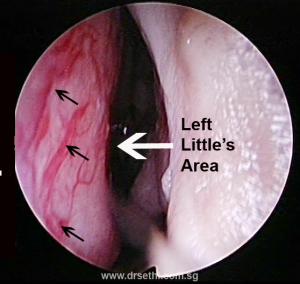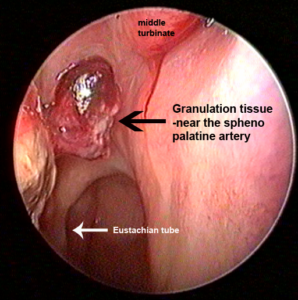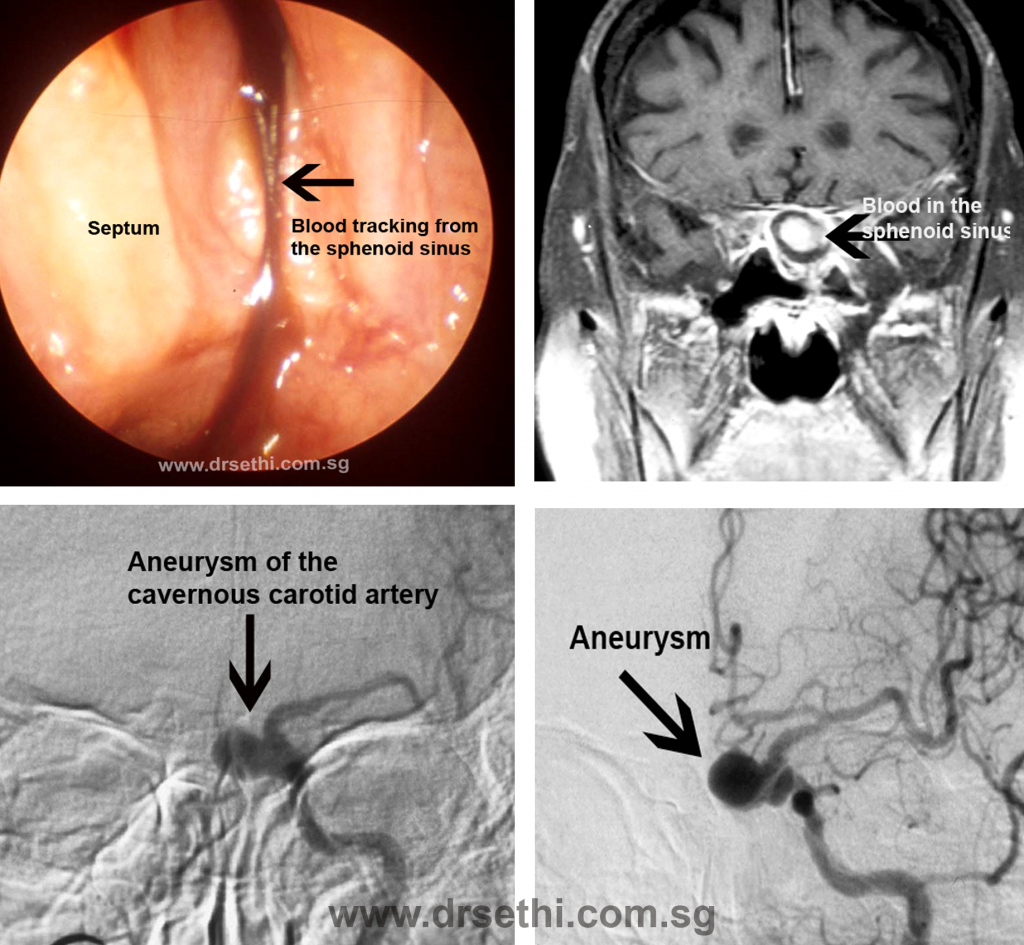Home / Nose Sinuses / Nose Bleeds
Nose Bleeds
Call +65 8125 3580
for 24 by 7 appointment
Why does my nose bleed?

One of the functions of the nose is to warm the air that we breath. To be able to effectively perform this function, it has a very profuse blood supply as it is the blood that warms the air. The major blood supply to the head, neck and the brain comes from the common carotid artery which divides into the external carotid artery and the internal carotid artery. The internal carotid artery is the main artery to the brain. The blood supply to the nose comes from both the external and internal arteries which form a very profuse plexus or a capillary network with in the nasal cavity. This capillary network is particularly profuse on the front part of the nasal septum and is called the Little’s area. The Little’s area is particularly subject to the quality of the air that we breathe as it is almost the first point of contact with the air. As such it is exposed to the pollutants and the temperature of the air. Excessive drying and crusting of this area may occur resulting in bleeding from the nose. Epistaxis or bleeding from the nose is a very common complaint with which patients present with. It is estimated that about 10% of the population will have an episode of epistaxis a year. There are several causes of bleeding from the nose, enough to write a book on the subject. Generally these may be local causes, where the pathology is in the nose or the sinuses. The cause may be systemic such as (among others) hypertension or defects in the clotting mechanism of the blood. Unlike the skin the nasal mucosa is very fragile and can bleed easily. The nasal mucosa is covered by a thin layer of mucus which protects it. In environmental conditions, particularly dry weather, the mucus may dry up causing the underlying mucosa to become exposed and therefore bleed easily. This tends to occur more in the front part of the nasal septum , the Little’s area. The bleeding is often mild occurs on blowing the nose and usually stops on pinching the nose. Sometimes when an underlying capillary is exposes or granulation tissue develops on the mucosa, it may not cease even on pinching the nose and may have to be cauterised. This can be done by an ENT doctor in the clinic. Other causes of bleeding from the nose include acute or chronic infection. The bleeding is usually mild and the patient will have other symptoms related to the infection. Tumors or growths within the nose and sinuses may present with mild, moderate or even severe bleeding depending on the vascularity of the tumors.

Epistaxis is a common presenting symptom of nose cancer. The bleeding is rarely severe or life threatening. Vascular tumors such as angiofibromas may bleed profusely if they are inadvertently biopsied in the clinic. Juvenile angiofibroma is a tumor that arises from the cells of the wall of a major artery to the nose. Postoperative bleeding from the nose may result after turbinate reduction surgery, septoplasty or endoscopic sinus surgery. Often not very severe or life threatening, it can sometimes very profuse particularly if a major artery is bleeding. Profuse or life threatening bleeding from the nose may result from a severe head injury where a major artery has ruptured. Rarely, aneurysms from the major blood vessels in or around the nose may present with life threatening bleeding from the nose. What to expect when you see an ENT doctor with bleeding from your nose:
- Detailed history: Your doctor will take a detailed history and try to determine the cause of the bleeding
- Nasal Endoscopy: It is very likely a nasal endoscopy will be done to examine the nasal cavity to look for a source of the bleeding
- Further tests or investigations will depend on the endoscopic finding. These may include imaging studies such as CT /MRI scan and blood tests.

Nose Bleed Treatment
If the source of your bleeding is from the mucosa overlying the front part of the nasal septum, it may need to be cauterised. This can be done in the clinic using silver nitrate or bipolar cautery. A minor bleeding vessel can also be cauterised with bipolar diathermy in the clinic. If the bleeding is quite profuse and nasal endoscopy is not possible, it is likely the nasal cavity will be packed with merocel. This provides tamponade to contain the bleeding. The nasal packing may be removed 24 hours later and nasal endoscopy done to identify the cause. If the bleeding is recurrent and does not stop despite nasal packing, and angiogram may ne necessary to identify the bleeding vessel. This vessel can then be embolised to contain the bleeding. In some cases, the main vessel supplying the nose ie the spheno-palatine artery can be ligated or cauterised with diathermy.
Below is a video clip of a patient who presented with severe nose bleed from the left side.
Nasal endoscopy identified the bleeding vessel which was then cauterised with bipolar diathermy. The procedure was done in the clinic. The bleeding stopped and patient discharged. There was no need for nasal packing or admission to the hospital.
Not sure if you're in need of treatment for nose bleeds? Speak to A/Prof Sethi to find out the right treatment for you at +65 8125 3580. Or book an appointment with A/Prof Sethi for a consultation on your symptoms and treatment options.
